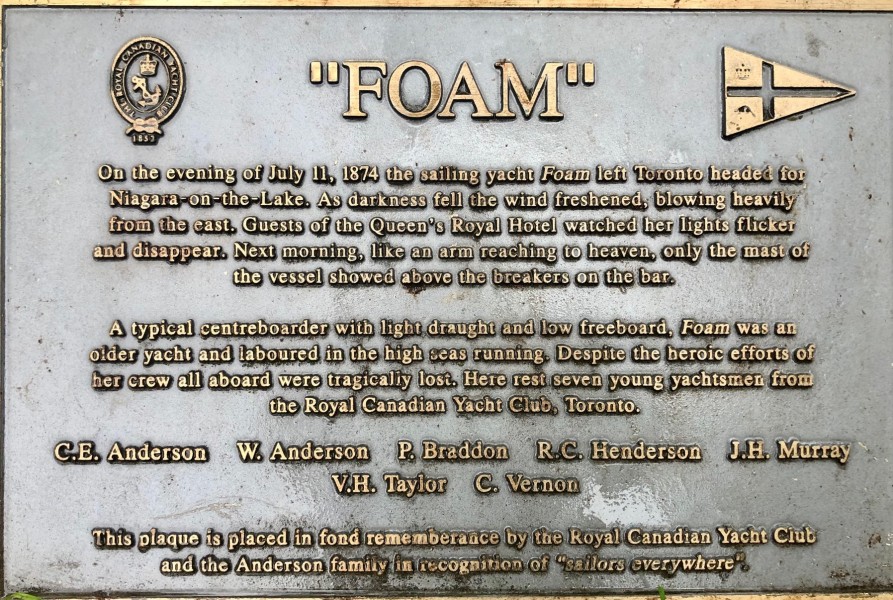Intrigued with the story of the sinking of the Foam, noted Niagara-on-the-Lake author Jean Baker researched and wrote a short vignette capturing the drama of the tragic events on that warm summer night, July 11, 1874, at the mouth of Niagara River and the controversy that surrounded the loss of seven lives.
Here’s the story Baker discovered. She published her tale in the St. Mark’s church newsletter in July 2000 and later a St. Catharines community newspaper:
Jean Baker
Special to The Lake Report
From a fine vantage point on the spacious veranda of the fashionable Queen’s Royal Hotel, the Chittenden sisters, Elizabeth and Dee Dee, teenage daughters of a Southern plantation owner who had moved to Niagara-on-the-Lake after the American Civil War, awaited the arrival of suitable dance partners.
They were enjoying a panoramic view of Fort Niagara, directly across the Niagara River on the American shore, and observing guests making their way by steamer and carriage to the hotel, now in a flutter of preparations for the weekly Saturday night dance, a fitting finale on this warm evening of July 11, 1874.
The sisters’ dance cards may have included a waltz with one of the young military officers from the encampment on the Commons nearby, or possibly a vigorous Scottish schottische with a partner from the yacht “Foam,” now heading into a freshening easterly wind as she sailed Lake Ontario from her mooring at the Royal Canadian Yacht Club in Toronto.
The Foam, formerly the John Powers, and described as a 30-foot centreboard sloop with low freeboard and long bowsprit, was owned by Robert Henderson and Charles Anderson. Her seven-man crew on that fateful night were all from prominent Toronto commercial and banking families.
Under darkening skies and failing light, heavy winds pounded the yacht as she approached the treacherous shoal, about three miles offshore where the strong current of the Niagara River merged with lake waters in a roiling maelstrom.
Sudden turbulence gripped the vessel, causing her to shudder on the bar as a rogue wave from the stern engulfed the cabin and cockpit, sinking the Foam, her four tons of iron ballast pulling her down to a watery grave.
From the hotel veranda, some of the dancers pausing for rest and refreshment reported having heard the bell of the warning buoy tolling eerily across the heaving waters. They casually remarked how chilly it was for an evening in mid-summer and were attracted by two flickering red and green lights “leaping and plunging in the darkness of the wind-whipped lake.”
None of the newspaper accounts of the time gave any indication of the competence of the Foam’s crew, praised on a memorial plaque in St. Mark’s cemetery as having made “heroic efforts to save her.” But prior to the sinking, other yachtsmen expressed misgivings, considering the craft a “skimming dish,” subject to “swamping and unsafe for open lake navigation.”
The Globe report of July 1874 suggested this was no time for moralizing, but it would appear that the boat’s owners were made aware of the potential weakness in the Foam’s design.
News of the Foam’s disappearance was telegraphed to ports around the lake. Search-and-rescue vessels included the chartered tug Young Lion and the yachts Oriole, Lady Stanley and Ripple. The doomed Foam was eventually located and raised by Captain Wyatt of the Young Lion and towed to Toronto.
However, an intriguing mystery surrounds the deaths of the seven young men. Were some of them found in their cabins “fast in their eternal sleep,” as suggested by one account, or were all the bodies washed ashore?
The mast of the Foam was not discovered until the morning of July 13, sighted by the captain of the Toronto steamer … and yet the plaque indicates that hotel guests spotted the mast above the breakers on the bar, pointing to the skies the morning after the tragedy, July 12.
Again, why was St. Mark’s chosen as the final resting place?
Burial took place later in July and August and a new inscription on the recently installed bronze plaque identifies the yachtsmen as C.E. Anderson, W. Anderson, P. Braddon, R.C. Henderson, J.H. Murray, V.H. Taylor and C. Vernon.
The handsome white granite headstone, surmounted by a Celtic cross, has suffered the ravages of time, the original inscription now illegible, but the whole site marked by a low iron railing is a poignant reminder of what the Niagara Advance described in 1936 as “one of the greatest tragedies which has ever befallen the sport of yachting on Lake Ontario.”
And what of the Chittenden sisters? By strange twist of fate, they also have a final resting place in St. Mark’s cemetery.
Who could have foretold what the future might have held for the young people if they had met together at the dance as planned?
Next: Almost everyone who wanders past the monument to the seven souls from the Foam, nestled in St. Mark’s quiet churchyard, has their own recollection about how the story captured their imagination. Our series continues with the musings of three of those locals and what they did about it.









